Grounded Beginner's Guide: 10 Tips For Staying Alive While Shrunken
Life as a bug-sized kid is tough, but these tips will help you thrive in your new life in the backyard.
Obsidian Entertainment's new title, Grounded, will seem a lot like other survival games at first blush--even though it's Honey, I Shrunk The Kids-like setting puts it at a super-small scale compared to titles like Minecraft or The Forest. Like those games, you still need to drink water and eat food to stay alive, construct shelters to keep from getting overwhelmed by indigenous life, and craft equipment to help you keep alive and thrive in your new surroundings.
Though Grounded has a lot in common with other games in the genre, its shrunken approach to the survival genre means it has quite a few of its own quirks. From how you'll uncover crafting recipes, to the creatures keen on eating you that live in the backyard, there are plenty of nuances to understand. Here's a quick rundown of 10 key tips that'll help you adjust to life in the lawn.
1. Pick Up Everything And Analyze It
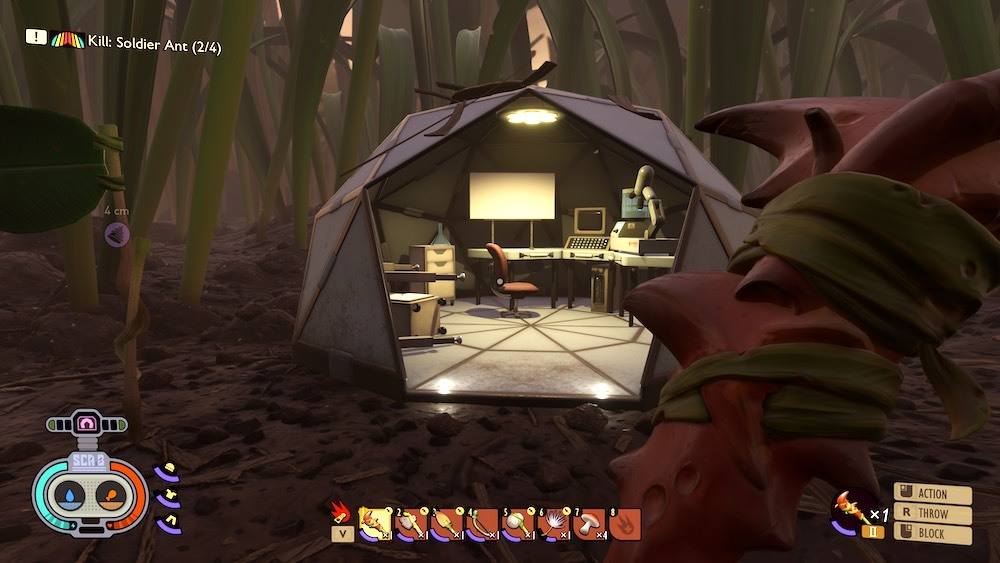
One of the first things you'll come across when you start a game of Grounded is a strange little science facility called a Field Station. This is your first inkling that there's something bigger going on here than a weird dream. Inside every Field Station is an item called an Analyzer--something that's extremely useful.
Like other survival games, you can pick up just about everything in Grounded, and most of those objects, like sprigs, grass planks, plant fibers, and sap, can be used to make stuff. You'll get some crafting recipes just from picking up objects around the world, but Field Stations are essential to unlocking even more. Use the Analyzer on your materials to find out more about them and to find new crafting recipes for using them. It has limited uses and has to recharge after you've scanned a few items, but as you explore, you'll find Field Stations all over the place that also have Analyzers. Make sure to mark them with Trail Markers (more on that in a minute) so they're easy to find.
2. Pick A Good Base Spot

The story quests you'll start with in Grounded will give you some stuff to keep you busy as you acclimate yourself to the game, but while there's a lot to accomplish on your first day, survival is still your main concern. After a time, the sun will go down in Grounded, and that's when life in the backyard becomes even more dangerous than it already is. You'll want to create a base relatively early, even if it's pretty rudimentary, so you have somewhere to sleep through the nights.
A good spot is in the early going near the Mysterious Machine, since you'll be spending a lot of time in that area. You also can't go wrong building near a landmark like a fallen juice box--or even inside a soda can. These locations drip juice you can drink that'll refill both your hunger and thirst meters, provide natural cover and protection, and can make base-building easy, so take advantage of them. You'll need an axe to cut down grass to make walls, so keep that in mind when crafting. But at the very least, build yourself a lean-to fairly early so you have a spot to sleep and respawn. You can also build lean-tos out in the world so you can change your respawn point as you explore to cut down travel time--but be sure to build them in protected areas, and not in places like spider dens where you might find yourself trapped and repeatedly killed by enemies.
3. Make Armor, Check For Perks
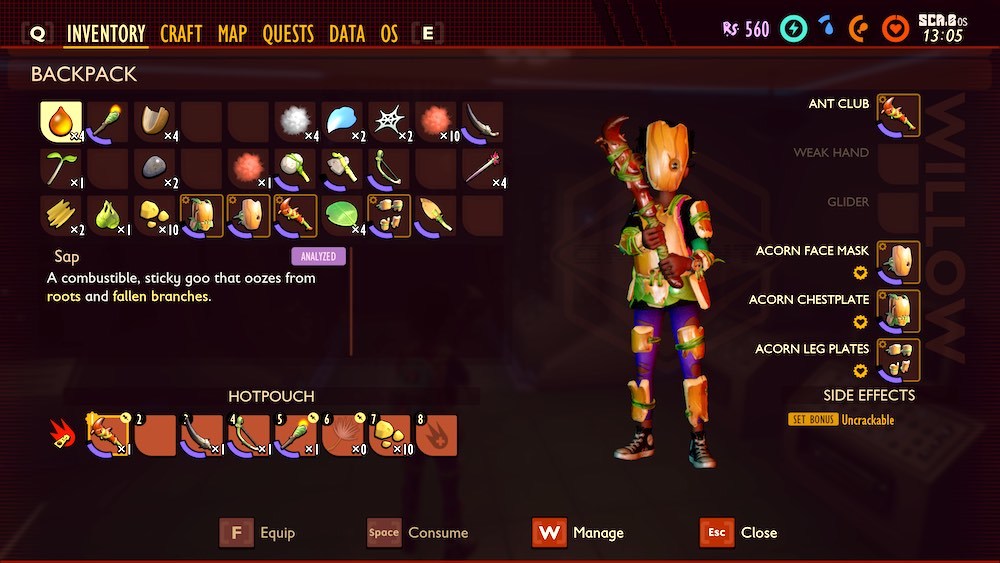
Before long, you'll find yourself fighting the various bugs in Grounded, and you'll probably find very quickly that protection is key. Combat isn't too difficult in general, but unaided, you'll take a lot of damage even from small enemies, and it can be tough to heal up in an emergency. Therefore, armor should be an early priority. You'll want to build a workbench near your base relatively early so you can start constructing armor out of whatever you find. The crafting menu will show you how much defense armor will afford you, and getting something on your body early can help you survive dangerous situations while you're learning the ropes.
Armor also carries different perks depending on what it's made from. Some armor might give you more benefits when you eat food, while other clothes can make you run faster. Pay attention to the perks listed on your armor in the "Inspect" menu so you know how to use it most effectively. (Weapons also have perks you'll want to pay attention to, because having the right gear can give you big advantages.)
Once you start to make your way toward the oak tree as part of the story, craft a hammer and smash up any acorns you find--their shells make for some of the toughest armor you can get early on, before scrapping with any of the bigger enemies around the backyard.
4. Avoid Spiders
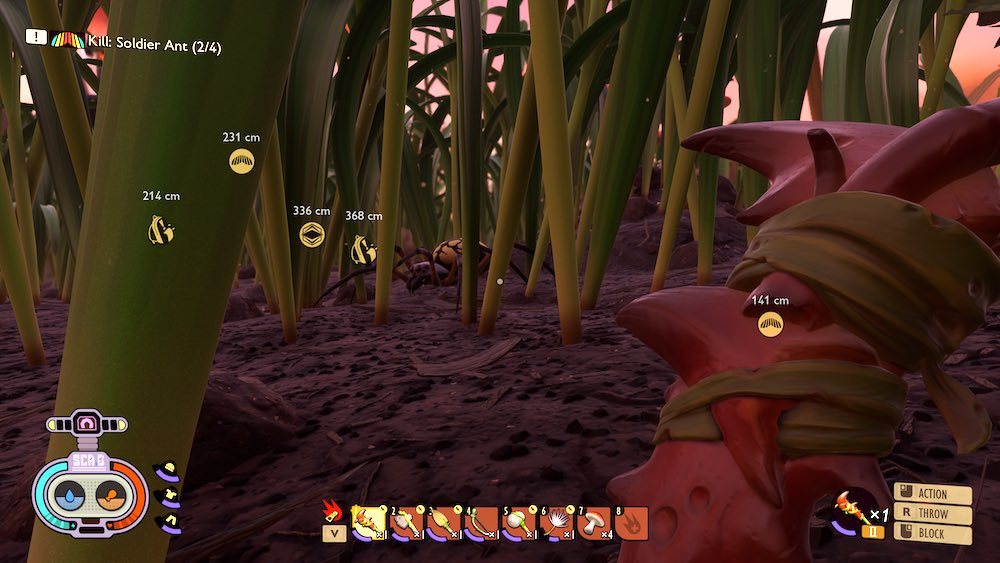
Most of the bugs you find in the first few hours of Grounded will leave you alone. Lawn mites are a bit aggressive, but they're tiny and easily dispatched, and bugs like ants and ladybugs will regard you curiously but go about their business, so long as you don't attack them. But some bugs, like beetles, are aggressive on sight--and some, like spiders, are deadly predators.
You'll find spiders before long as you approach the oak tree, and they can be seriously frightening, as well as extremely deadly. Armor will help you survive any run-ins, but until you get better weapons than the spear you can craft at the start of Grounded, you should keep your distance. You can tell when a spider spots you because it'll stop and put its legs up; if its eyes go red, it's after you. The good news is that you can sprint away from pretty much any combat encounter to escape, so spiders are easily fled. You can also usually spot and avoid them at a distance by watching for blades of grass shaking as if something big is pushing through them--something big is pushing through them, so go the other way.
5. Watch For Dew Drops
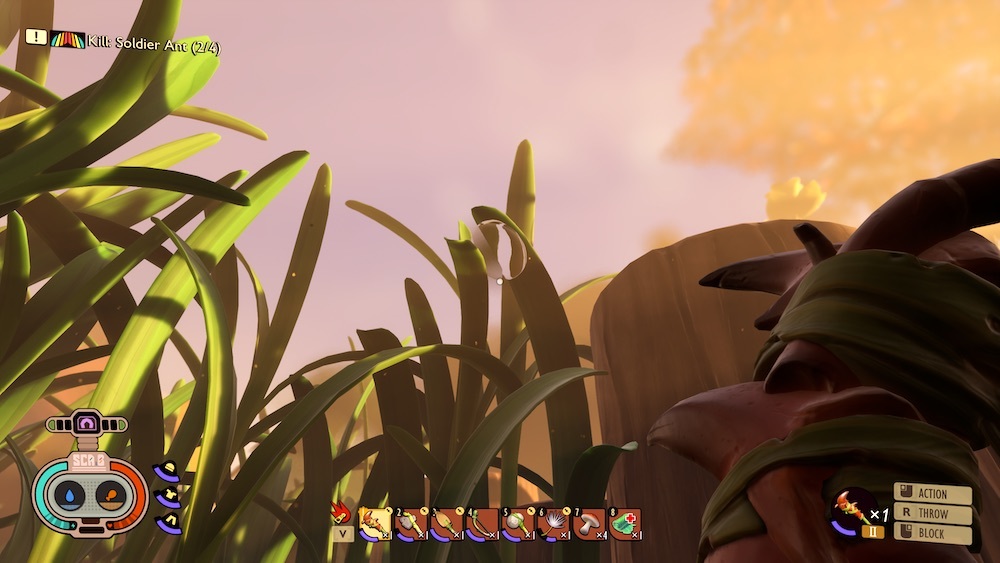
Grounded is first and foremost a survival game, which means you need to keep yourself fed and hydrated in order to stay alive for any length of time. Food is pretty easy to come by, as the game's tutorial will tell you--there are lots of mushrooms growing around the backyard that you can snack on, and they'll keep you going until you start figuring out how to craft the items you need for cooking bug meat. Water, on the other hand, isn't as easy. You'll find a lot of puddles in the backyard, but drinking that water isn't the greatest idea.
Puddle water makes you a little sick in Grounded, so while your thirst meter is replenished, your health meter gets knocked down. That means you should carry spare food if you think you're going to have to imbibe from a local gross puddle. You can get around that issue by finding clean water, generally in dew drops. These aren't impossible to find, but they are somewhat rarer than puddles and can be tough to spot. Look for them hanging on grass blades above you--they're easily knocked down by throwing a rock or some other object at them. Watch for and drink dew just about whenever you can for big boosts to your thirst meter, without the drawbacks. Watch your crafting menus for the ability to build objects that'll catch water at your base so won't have to hunt for it.
6. Block, Strafe, And Stun In Combat
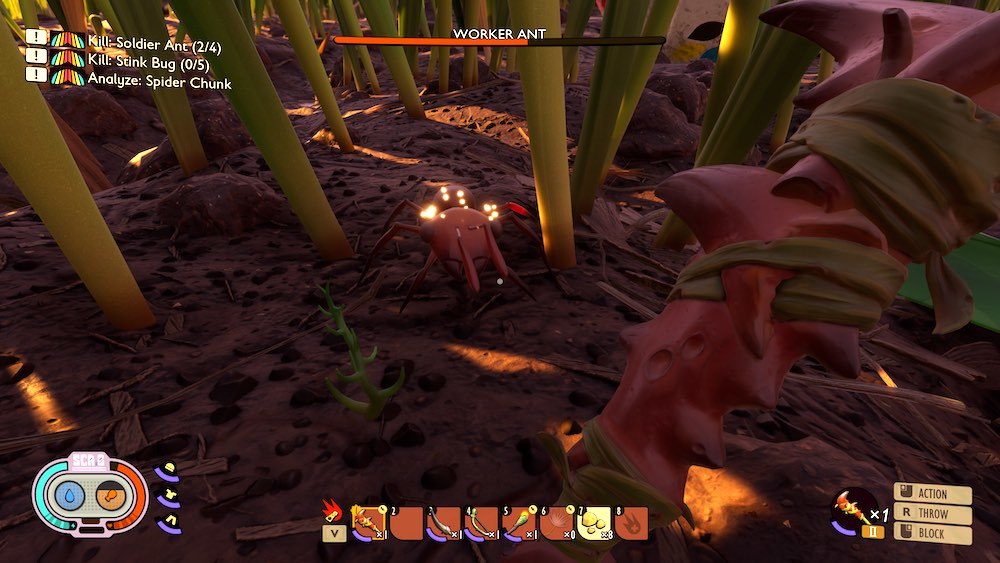
You'll be fighting a lot of insects in Grounded after a time, and sooner or later, you're going to want to venture into the tougher bugs' territories or into the underground tunnels that house spiders so you can get better resources. Armor will help you in these situations, but practice with the combat system can get you out of most situations regardless of what your equipment looks like.
Fighting in Grounded is about stamina management. The more times you swing a weapon or block an attack, the more your stamina depletes, so you need to be careful not to overdo it with slashing at an enemy. Meanwhile, bugs will telegraph their attacks pretty obviously before they do them, and they tend to fall into two camps: smaller, quicker jabs and slashes, and larger lunge attacks. Once an enemy makes the animation to telegraph an attack, you can often strafe to the sides, since they won't turn once they're committed. You can also block attacks, which is key to staying alive--blocking reduces the damage you take, and if you can manage to hit the block button the instant an attack would land, you can deflect it for almost no damage at all. Getting good at blocking enemy attacks, smart strafing, using weapon perks like Stun will help you deal with most threats pretty easily.
You should also note that if you get into trouble, you can often trick bugs into fighting one another to give you a chance to regroup, heal up, or escape a battle. Pay attention to which bugs are aggressive with each other and you can use their behaviors to your advantage.
7. Mark Key Locations
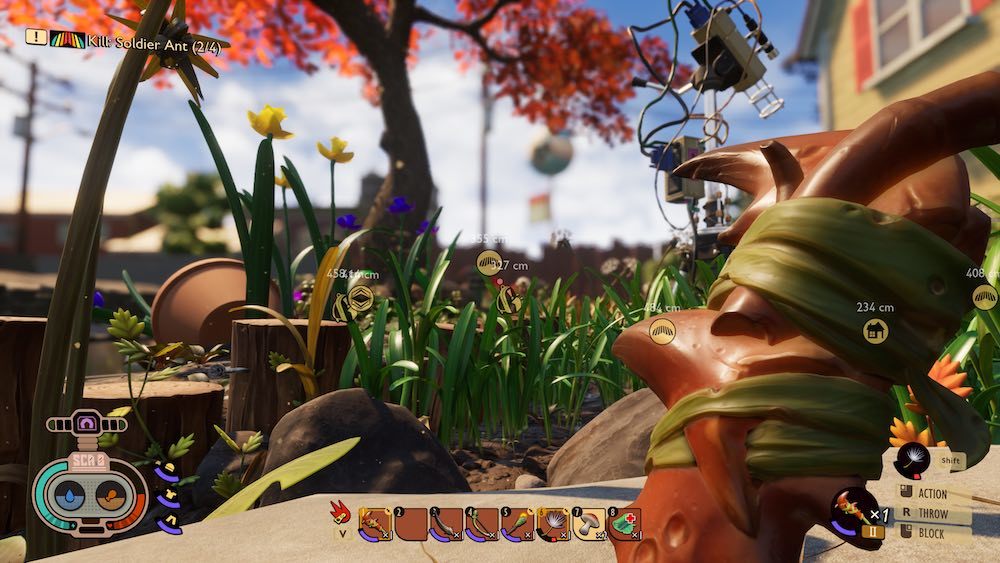
The backyard of Grounded is huge and it's very easy to get lost in it. As you explore, you'll discover important landmarks, like a fallen piece of wood or various tipped-over juice boxes, that can help you find your way around, but opening your map constantly puts you at a disadvantage and leaves you vulnerable to attack. Luckily, you can construct your own custom waypoints that appear on the screen while you're wandering around to help you find things, and you should do so anytime you find something worth remembering so you can find it easily.
Waypoints are called Trail Markers in the crafting menu, and you'll need clover leaves to build them. You should keep some on-hand at all times so that any time you happen across a Field Station, a spot with particularly useful resources, or anything else worthy of note, you can drop a flag. Pop one next to your base(s) so you can easily find them when you're done exploring. Smart, organized use of Trail Markers makes mapping the backyard much easier, so get in the habit.
8. Climb Whatever You Can
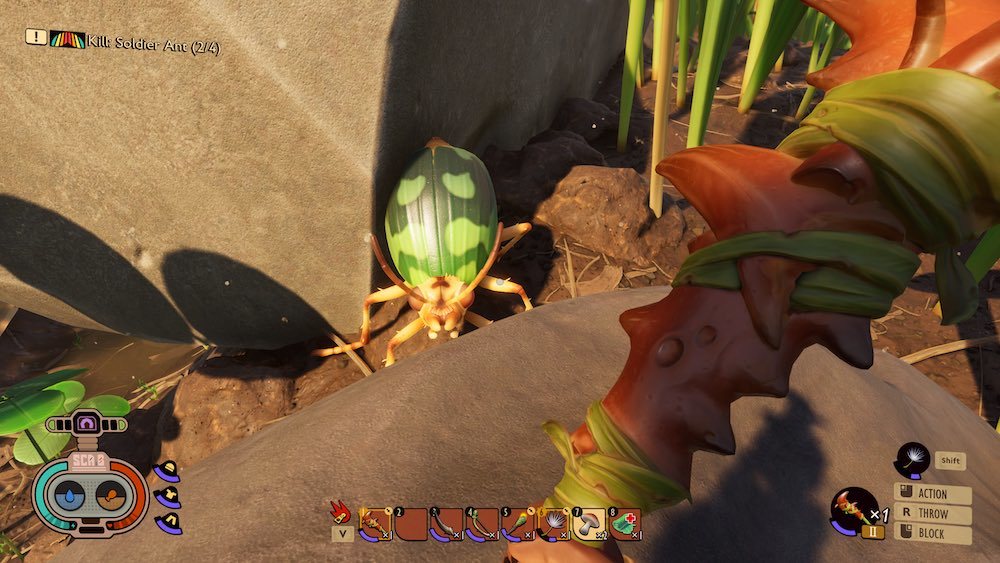
Trail Markers are handy because it can be tough to see what's around and where you're going in Grounded, what with all the grass and weeds blocking your view wherever you go. Wandering around on the ground can be disorienting, but a lot of objects in the game will support your weight and allow you to get up into the air, where you can see farther, orient yourself better, and most importantly, avoid bugs.
If you can get into the air, you should. Bent grass blades, tree roots, leaves, even clovers make handy platforms. Bugs won't chase you onto most objects, and you can even sometimes build in these elevated locations for added protection. What's more, with enough height, you can make traveling quicker and easier, thanks to gliders. Speaking of which....
9. Grab A Dandelion Tuft For An Early Glider
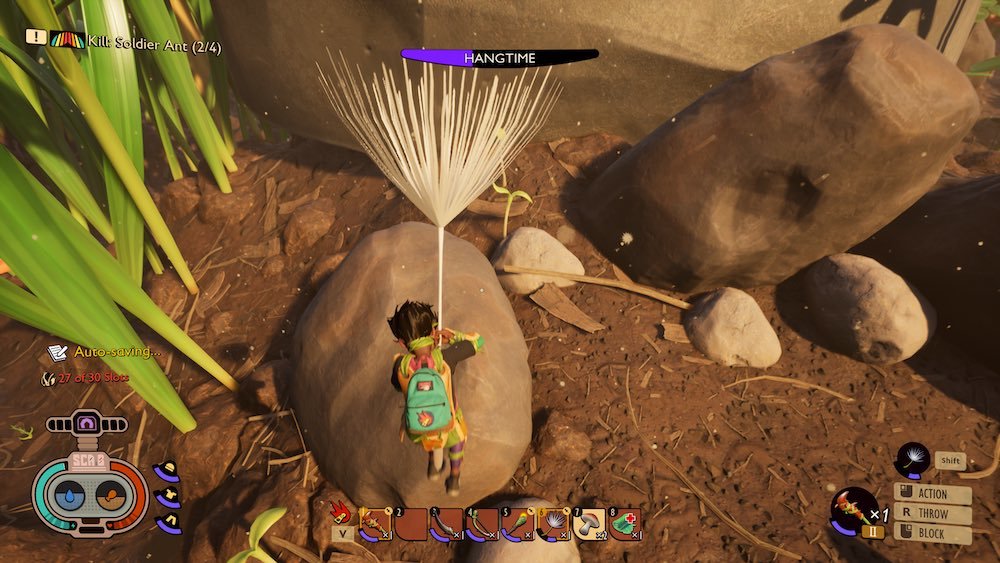
You will take fall damage in Grounded, and while getting off the ground has its benefits, it can be easy to fall off stuff and get injured. A glider is a piece of gear you can make that can help with that, but rather than crafting one, you can get a glider quickly and easily by grabbing one of those white dandelion tufts that drop near the plants every so often. Snag it and add it to the "Glider" spot on your equipment list on the right side of your inventory, and you'll be able to pull it out with the shift key anytime you're falling.
While a glider will save you from injury, it's even better as a means of traversal. Climb high enough and you can use the glider to travel a long distance without running on the ground and risking injury. Snag a dandelion glider early and cut down on your travel times.
10. Gather Raw Science

Once you head to the oak tree as part of the story missions in Grounded, you'll discover a hidden lab beneath it. Inside is Burg-L, a robot who knows something about the experiment that shrunk you. In addition to. providing you with quests to keep you busy and help you explore, Burg-L will answer some questions about what's going on and sell you new crafting recipes, but only if you gather a new resource called Raw Science.
There's not a real explanation of what Raw Science actually is, but you'll find it around Grounded, floating in weird places--it's a bubble of pink goo, and you want to grab it whenever you see it. Completing quests and crafting new items will also provide you with Raw Science, so it's good to keep messing around and trying new things. Raw Science is essentially a currency you can use with Burg.L. to buy stuff from his little shop, so you want to gather it when you can and keep an eye on your supply.
Got more essential tips for staying alive in Grounded? Drop them in the comments below.
Got a news tip or want to contact us directly? Email news@gamespot.com
Join the conversation